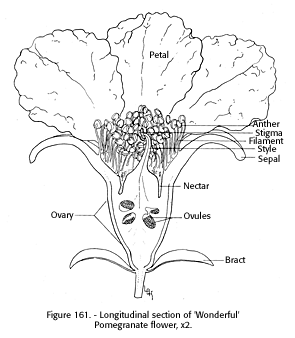POMEGRANATE
Punica granatum L., family PunicaceaePomegranates were grown in 1970 on 1,220 acres in California, the leading State in the production of this delicious fruit (Henderson and Kitterman 1971). The largest single planting was 120 acres (Larue 1964). The estimated value of the crop is less than one-half million dollars. Average production per acre is about 5 tons of fruit. Only one cv., 'Wonderful', is grown commercially in California. It grows best in areas of cool winters and hot dry summers (Purseglove 1968*).
Plant:
The plant usually grows as a bush or shrub 6 to 15 feet in height and is deciduous in the cooler areas of its range. Spacing in the orchard is 12 to 15 feet, or the plants are doubleset in hedgerows with more space between rows.
The fruit is a large, globose berry, red-green or violet when ripe (fig. 160). Its pulp is eaten out of hand and in salads, or its juice is used in a refreshing drink or sirup. A jet-black ink is made from the rind. Kihara (1958) stated that normal fruit contains an average of 667 seeds. Evreinoff (1963) stated that vegetative growth starts from mid-March to mid-April and flowering is primarily in May.
[gfx] FIGURE 160. - Mature pomegranate fruit on the tree.
Inflorescence:
From one to several flowers may be borne on a twig, one being terminal, the others lateral and solitary. The odorless but colorful flowers are large, 1 1/2 to 3 inches in length, campanulate or cylindrical, and generally reddish but sometimes yellow to white. There are five or more petals, some of which may be doubled. The stamens are numerous, erect to slightly curved at the apex, and red (fig. 161). The anthers are yellow. The ovary is many celled, each cell with numerous ovules. The style is yellowissh red and roughly an inch long. The stigma is globose or truncate and yellowish green (Bailey 1916*, v. 5., pp. 2750- 2751, 2861-2862; Knuth 1908*, p. 440; Ochse et al. 1961).
The pomegranate flower has been referred to as nectarless; however, flowers of cv. 'Wonderful', grown in Tucson in 1973, contained several drops of nectar with 27 percent soluble solids (sugars).
The flowers are primarily of two types: the fruitful, large, long- styled, long-stamened, colorful flowers, in which the anthers and the stigma are at about the same height; and the smaller, barren, short- styled, short-stamened flower, in which the stigma is far below the anthers. Occasionally, "intermediate" flowers have styles that may equal the length of the long-styled flowers or be as short as the short-styled ones. Those with long styles occasionally become fertilized, but only rarely does such fruit mature and then it is malformed and defective. On the contrary, short-styled flowers are never fertilized and soon shed. The petals of these are a dull, pale rose, and the pollen is defective (Hodgson 1917).
The long-styled flowers usually develop on old wood, whereas the short-styled flowers develop on new growth. The relative proportion of each is influenced by many factors. The best fruit is obtained from the early flowers, probably because they develop during more favorable meteorological conditions (Evreinoff 1953).
[gfx] FIGURE 161. - Longitudinal section of 'Wonderful' pomegranate flower, x 2.

Pollination Requirements:
Little is known about the pollination of pomegranates. Knuth (1908*, p. 440) stated that beetles belonging to the genera Cetonia and Trichodes effect both cross- as well as self-pollination, while devouring the flowers. The ability of the plant to self-pollinate or its need for transfer of pollen either within its own flower, between flowers, or between plants is unknown.
Kihara (1958) reported the discovery of a "seedless" pomegranate in which the pollen was sterile but the fruit developed. It had only half (307) of the normal number of developed embryos. These were not viable seeds; however, the size of the fruit was normal.
Pollinators:
Where no nectar is produced, only pollen-collecting insects would be of value to the blossom. If beetles contribute to the pollination of this plant, as Knuth (p. 440, 1908*) indicated, the visitation by pollen- collecting bees would appear to be much more valuable. No information is available on the degree of benefit such flowers may derive from beetles or, if bees are beneficial, how many bee visits would be desired.
Pollination Recommendations and Practices:
There are no recommendations for the use of pollinating agents on pomegranates, but some growers in California arrange for honey bee colonies to be placed in or near their fields, believing that their presence benefits pomegranate fruit production.
LITERATURE CITED:
EVREINOFF. V. A.
1953. [POMOLOGICAL STUDIES OF THE POMEGRANATE.] Ecole Natl. Super. Agron. Ann. 1: 141-154. [In French.]HENDERSON, W. W., and KITTERMAN, J. M.
1971. 1970 CALIFORNIA FRUIT AND NUT ACREAGE. U.S. Dept. Agr. Statis. Rptg. Serv., 19 pp.HODGSON, R. W.
1917. THE POMEGRANATE. Calif. Agr. Expt. Sta. Bul. 276, pp. 163-192.KIHARA, J. H.
1958. BREEDING OF SEEDLESS FRUIT. Seiken Ziho 9: 1-7.LARUE, J. H.
1964. POMEGRANATES: BACKYARD FRUIT WITH COMMERCIAL IDEAS. West. Fruit Grower 18(3): 27-28.
